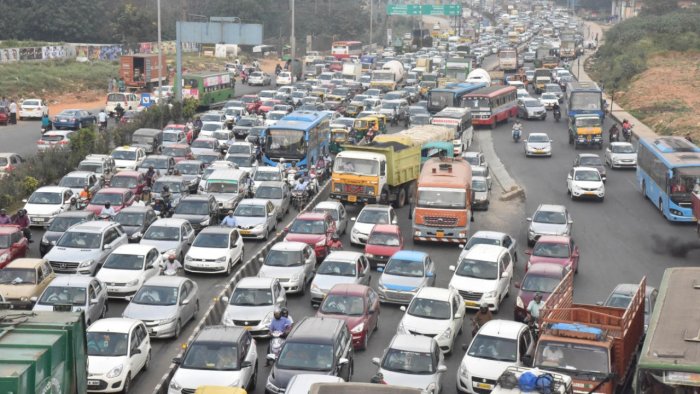Published on: November 3, 2022

Decongestion of Bangalore City
Decongestion of Bangalore City

Why in news?
The foundation stone for the Bengaluru suburban rail project was laid and an ambitious 40-month target to “decongest Bengaluru” was set.
Initiatives taken to decongest Bengaluru:
- Authorities to decongest 10 major bottlenecks in Bengaluru city, including the infamous Silk Board junction.
- The Bengaluru Traffic Police (BTP) to enforce traffic channelization and diversions to ease the congestion at congested junctions.
- A signal synchronisation project for the central business districts and high-density corridors is in the pipeline.
Reasons for congestion in Bengaluru:
- Ongoing infrastructure projects,
- re-opening of school,
- people returning to work from office,
- potholes and flooding of roads,
- unreliable public transport
Surveys that gives information about congestion condition in the city
Openly accessible surveys:
- The comprehensive Mobility plan for Bengaluru(CMP 2020),
- The Comprehensive Traffic and Transportation Study (CTTS 2018), and
- the Comprehensive Traffic and Transportation Plan
They provide a broad understanding of the traffic situation.
How surveys are helpful?
- Essential for clearer perspective on issues such as gridlock at major junctions and lower-than-forecasted metro ridership.
- to identify the root causes and develop traffic decongestion measures
- The scale and dynamic nature of the city’s traffic situation, coupled with pandemic-induced changes in people’s travel behaviours, are fresh data collection.
- Household travel surveys are one of the primary sources for detailed information on the commuting patterns of residents.
Importance of Traffic and transportation survey reports:
- They help gain insights on various aspects such as daily trip rates and travel mode share as well as their distribution across different zones in a city.
- Surveys are common around the globe, including India. They are conducted regularly to track changes in travel patterns.
- Scientifically designed, periodic household travel surveys would help develop long-term solutions to decongest city.
- Fare survey can capture the fares commuters can afford and accordingly help adjust bus and metro fares.
- Traffic counts along major roads and turning counts at major intersections can gauge the performance of the infrastructure in terms of the level of service
Use of openly accessible database
- It would benefit the ‘Decongest Bengaluru’ initiative by providing impetus to research in the domain thereby enabling academic institutions, research organisations, and policy think-tanks to develop and suggest viable solutions.
- Findings will act as an input for authorities to develop data-driven long-term measures to “decongest” cities.
Steps to be taken to decongest Bengaluru
- To facilitate active transport which would be to make an inventory of the required infrastructure like footpaths, cycle tracks, and parking spaces as per relevant Indian Roads Congress standards.
- “Parking Policy 2.0” suggested the utilisation of parking revenue for active transport infrastructure.
- the survey data be anonymised, digitised, and collated in an openly accessible database. Based on CMP Bengaluru standards, a database should be constructed to collate data held in silos with various public and private entities
- CMP Bengaluru 2020 suggested much needed data-sharing standards for urban transport data.
Way forward
- The success of these surveys primarily depends on active public participation, which can be ensured by awareness campaigns and attractive incentives to survey participants.
- Development of viable solutions to decongest city needs wide-ranging among various agencies, both public and private.
For example:
- The Urban Planning measures: The city planners must take measures that control and change the shape of the city itself, by controlling the urban form, land use and design of individual neighbourhoods. Urban form control includes compaction (where building inside core is encouraged) and densification of the city (in which low-rise housing is discouraged and highrise buildings are encouraged). Control on land use ensures that workplaces and residential zones are evenly distributed across the city so that the city does not experience asymmetrical traffic rush.
- Transportation planning measures: These measures plan and manage the transportation-related infrastructure.
- Traffic Control measures: adequate traffic control measures are needed. This includes planning and managing traffic signals and lane management. For example, reserving lanes for buses (Bus Priority Lane) and high-occupancy vehicles, reversing a lane during peak traffic to increase the road capacity in one direction, etc.
- Meanwhile, residents can play an impactful role in decongesting cities by avoiding or reducing commutes by personal vehicles and switching to public transport and active transport options.
Based on the above article, answer the following question
- Despite having public transport options including BMTC and Namma Metro, the traffic congestion remains unresolved. What is the reason behind the congestions and briefly explain about measures taken by the government in decongestion of cities
- What are openly accessible surveys? How are they useful in decongestion of roads in cities?

